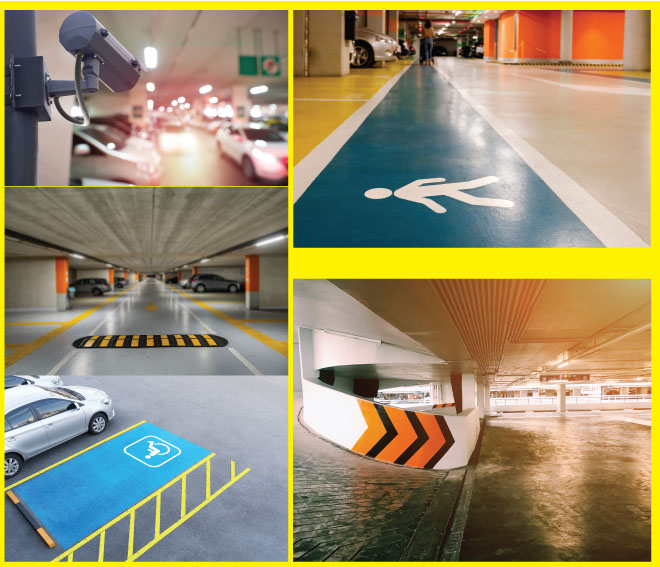
Did you know that one in five car accidents happen within a car park? However, many of these can be avoided by having the correct signage in place, clearly displayed within a multi-storey or single-storey space.
Learn how different layouts and signs can contribute towards a safer space for all, with this informative guide to designing a safe car park.
How to Make a Car Park
The Highway Code stipulates "references to ‘road' generally include footpaths, bridleways and cycle tracks, and many roadways and driveways on private land (including many car parks)”. Therefore, professional road signs can and should be displayed in any car park environment including but not limited to supermarkets, shopping centres and multi-storeys.
Include Pedestrian Crossings
These features should always be included in modern car park designs and clearly highlighted with pedestrian crossing signs, given the close proximity between people and cars in a restricted space. These crossings’ white markings must be prominent and visible to drivers as well as those navigating the car park on foot. Taking the form of horizontal lines, these features should be 2.4 metres wide. Using a footprints symbol heavy duty stencil along a designated walking route allows multiple markings to be created.
While drivers should observe the Highway Code’s rule that pedestrians have the right of way for consistency and peace of mind, showing caution beware of moving vehicles signs will remind pedestrians to stay alert when crossing. Car park pedestrian safety exists to protect all parties from accidents.
Control the Traffic Speed
Designers can reduce the chance of accidents by highlighting the reduced speed limit in car parks (10mph). Reminding drivers to slow down, with clear to understand 10mph speed limit signs, can avoid collisions, scratches to other vehicles, and most importantly, injuries and fatalities.
This need to enforce a lower speed is especially important in car parks, as people will typically have been driving at higher speeds before entering the site. Speed bumps help to physically slow vehicles, limiting the damage which might be caused by irresponsible drivers.
Shape the Flow of Traffic
There are a number of signs that can encourage safer behaviour. New drivers or those unfamiliar with the area or car park will especially benefit from having clearly displayed signs visible at the right height and position, as they navigate the car park.
Knowing which way to turn can be addressed with the corresponding right only (one way) or left only (one way) signs for drivers. These signs can signal which ramp drivers should use to ascend or descend in a multi-storey car park.
Similarly, no entry and no exit signs help to control the flow of traffic, avoiding head-on collisions. Automatic barriers will also limit the number of cars that can physically enter the site. This traffic management technique is essential to avoid congestion.
These signs should be paired with sufficiently bright road markings in case the signs are missed.
Consider User Safety
Designing to comply with car park health and safety regulations is more than a ‘good idea’. It is governed by The Health and Safety at Work Act 1974, which specifies that “car park owners and any contractors operating car parks on their behalf have a responsibility to ensure that car parks are safe to use”.
Consider what times your car park will be used by drivers and pedestrians. Adequate lighting should be maintained for safety reasons, with one Your Parking Space national survey finding that “more than a third of people say they feel unsafe in car parks - especially when it’s dark”.
Take steps to deter criminal and anti-social behaviour by confirming you are monitoring the site with effective CCTV cameras in 24 hour use signs. Safety in car parks matters regardless of the scale or location of the site.
Meet Users’ Additional Needs
It is important to note that any car park must accommodate the needs of disabled drivers. A disabled badge holder’s only sign informs all drivers which bays are allocated for disabled drivers with a permit to use (exclusively). Usually located nearest to the store or pedestrian entrance (if covered), they provide better access for these car park customers.
Indeed, Government guidelines state that such parking bays should occupy 6% of the total parking spaces “unless otherwise covered by local planning regulations”. They need to be 1.2 metres wider (at 3.6 metres) than standard bays and display either the words “DISABLED ONLY” or a wheelchair symbol. Here, our disabled (logo and text) heavy duty stencil or disabled parking symbol thermoplastic markers will remind drivers of these spaces’ purpose and allow everyone to be able to utilise the car park.
Protect Car Park Customers with Label Source
Meet your legal requirement to design a safe car park for pedestrians and drivers, with our high quality road signs and stencils. Able to be used in conjunction with design features such as lighting and barriers, they create the safety everyone deserves when using a car park. Browse our trusted Traffic Control Management page to find out more.